The Benjamin Franklin class consisted of 12 nuclear-powered ballistic missile submarines. These subs, completed between 1963-67, stood out for being the quietest and heaviest among all Lafayette types.
Despite their visual resemblance to the Lafayette class, the Benjamin Franklin class boats distinguished themselves with improved and quieter machinery. They also accommodated 28 additional crew members.
| Benjamin Franklin Class SPECIFICATIONS | |
|---|---|
| Length: | 425 ft (129.57 m) |
| Height: | 32 ft (9.75 m) |
| Width: | 33 ft (10.06 m) |
| Weight: | 7,350 tons surfaced 8,250 tons submerged |
| Armament: | 16 steam ejection tubes for Polaris, Poseidon & Trident missiles and four 21-inch torpedo tubes |
| Speed: | 21 knots on the surface 16 knots submerged |
| Powerplant: | Single S5W pressurized water nuclear reactor |
| Crew complement: | 141 men; 15 officers, 126 enlisted |
| Contractors: | General Dynamics Electric Boat Division, Mare I NSYd, Newport News, Portsmouth NSYd |
| Names of submarines: | (640) Benjamin Franklin, (641) Simon Bolivar, (642) Kamehameha, (643) George Bancroft, (644) Lewis and Clark, (645) James K. Polk, (654) George C. Marshall, (655) Henry L. Stimson, (656) George Washington Carver, (657) Francis Scott Key, (658) Mariano G. Vallejo, (659) Will Rogers |
This class formed the last submarines of the “41 for Freedom” submarines that served as the cornerstone of the US underwater deterrent strategy during most of the Cold War.
The Ohio Class replaced the Benjamin Franklin- and Lafayette-class ballistic missile submarines in the 1980s.
Description
Design
The Benjamin Franklin class submarines, known as SSBN 640, were redesigned versions of the Lafayette class, based on the BUSHIPS sub-design 216. The fleet consisted of two distinct designs. The first six submarines, including Benjamin Franklin, Simon Bolivar, Kamehameha, George Bancroft, Lewis and Clark, and James K. Polk, were based on the SCB 216 Mod 2 design.
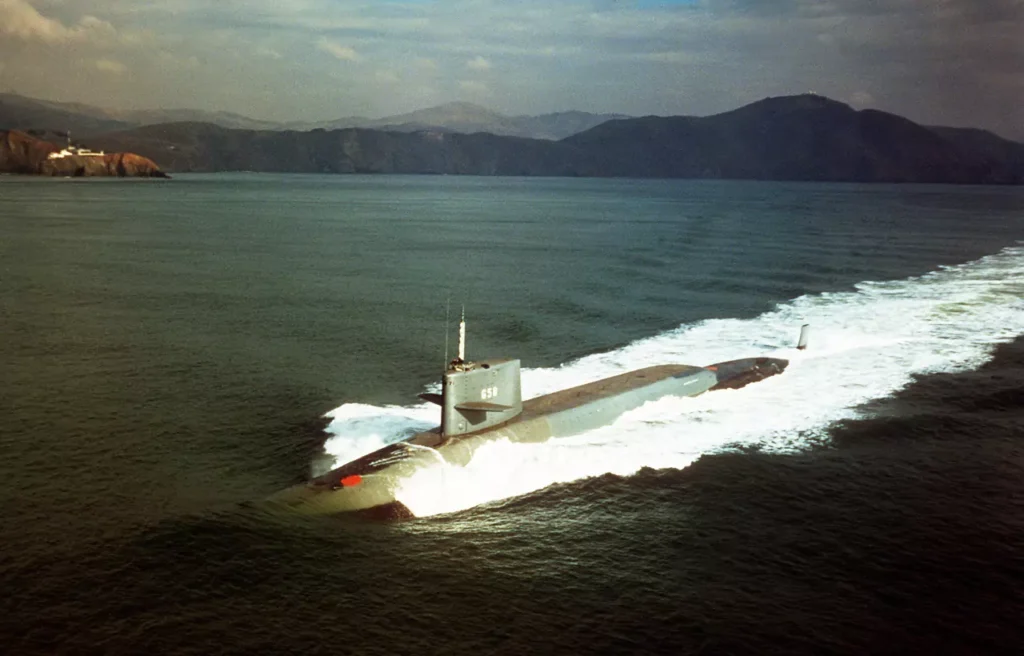
The other six, including George C. Marshall, Henry L. Stimson, George Washington Carver, Francis Scott Key, Mariano G. Vallejo, and Will Rogers, followed the SCB 216 Mod 3 design.
The SCB 216 Mod 2 design incorporated quiet machinery by mounting the turbines and propeller shaft housing on shock-absorbing material, reducing noise. Additional noise reduction measures included the installation of cork and rubber panels in high-noise areas. The speed performance matched that of the 627 class, capable of over 20 knots when submerged.
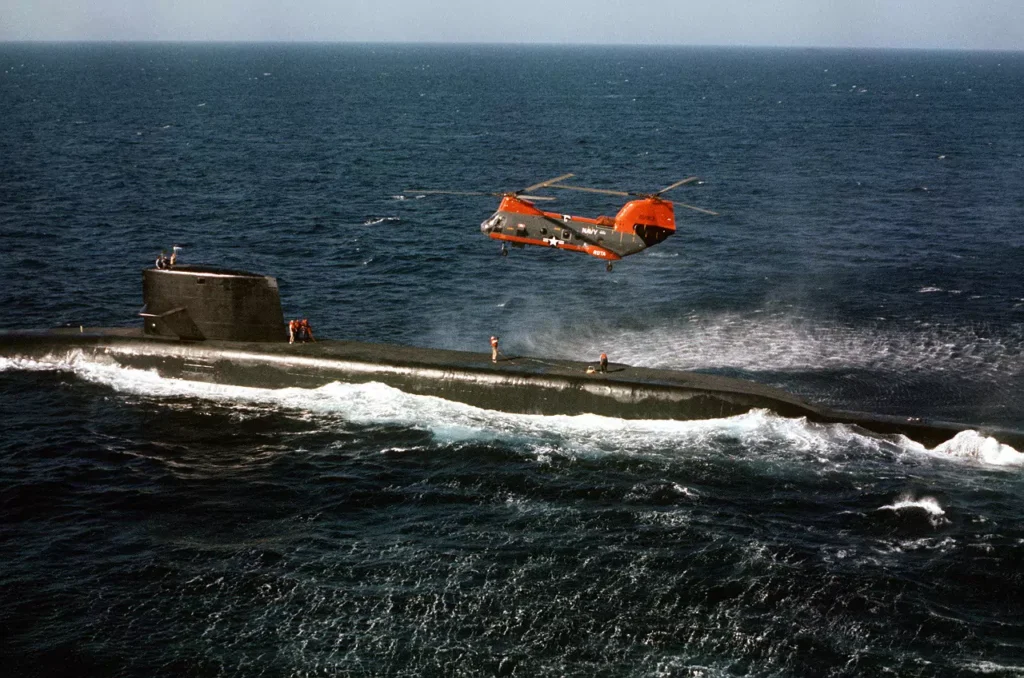
Despite appearing large externally, the Lafayette, James Madison, and Benjamin Franklin class submarines were compact inside. Spaces were efficiently used with triple bunking being standard. The largest open area was the enlisted mess area, and the medical facility was equivalent to four phone booths, with the officers’ wardroom serving as an operating theater in emergencies.
The 640 class had the same SCB 216 hull design as the previous 616 and 627 class submarines, with a length of 425 feet and a beam of 33 feet. They were equipped with an updated BQR-21 conformal sonar featuring Digital Multi-beam Steering (DIMUS). Some submarines in the 640 class were later modified with twin vertical end plate stabilizers, replacing the single tall fin/rudder.
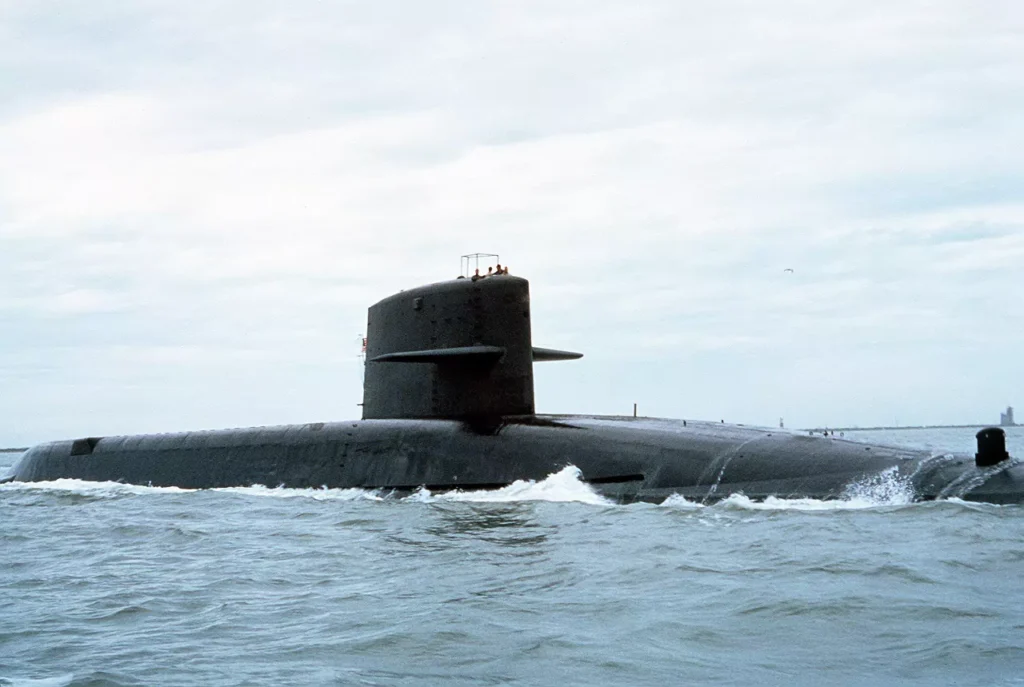
The Benjamin Franklin Class, along with the Lafayette and James Madison Class submarines, used either the Towed sonar array BQR-15 or BQR-17, depending on when it was installed. The BQR-15 was the earlier version, while the BQR-17 was a later upgrade. This sonar system was set on a long wire from the right side of the submarine. It carried devices that could listen to enemy submarines or ships.
The class of submarines also had different types of distractions, like the WLR-8. This tool mimicked the noises that other submarines make. The 640 Class submarines were also equipped with devices that explode and make noise, which are launched from the middle of the submarine. This noise hides the submarine’s noise and allows it to get away from enemies who might have noticed it.
Missiles
The Benjamin Franklin class submarines were initially launched and commissioned with the Polaris A-3 ballistic missile.
However, between November 1972 and September 1974, during their first overhaul periods, they were upgraded to the Poseidon C-3 missile.
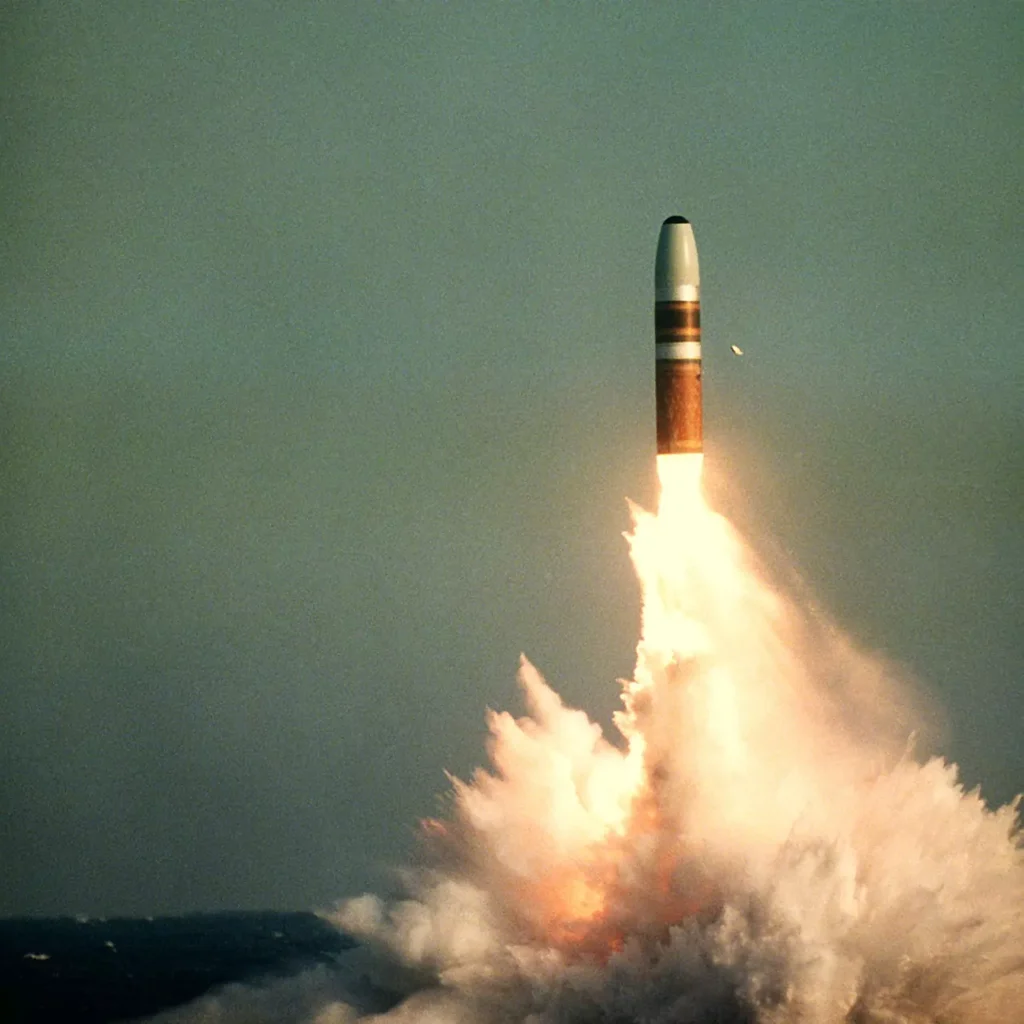
Further enhancements were made as the more powerful, longer-range Trident I C-4 became available, and these were also integrated into the subs.
Notably, the USS Benjamin Franklin, Simon Bolivar, and George Bancroft received their upgrades during their second overhaul. In contrast, Henry L. Stimson, Francis Scott Key, and Mariano G. Vallejo received their back fits pier side by a subtender.
Incorporating the Trident necessitated an electronic upgrade, including improved navigational and satellite receiving systems.
Propulsion
Every submarine in the class used a 15,000 shaft horsepower Westinghouse S5W nuclear reactor, which was cooled by high-pressure water, for power.
Torpedoes
Like other submarines in the 616 and 627 classes, the Benjamin Franklin (640) class was equipped with four Mark 65 torpedo tubes at the front, each 21 inches in size.
These tubes held Mark 48 torpedoes that served two purposes and were managed by a Mark 113 Mod 9 system for firing the torpedoes.
Construction
The 12 ships of the class were commissioned between 1965 and 1967. In the fiscal 1965 shipbuilding program, plans proposed four additional units of this class to complete the envisioned 45-submarine Polaris force. However, these ships were never constructed.
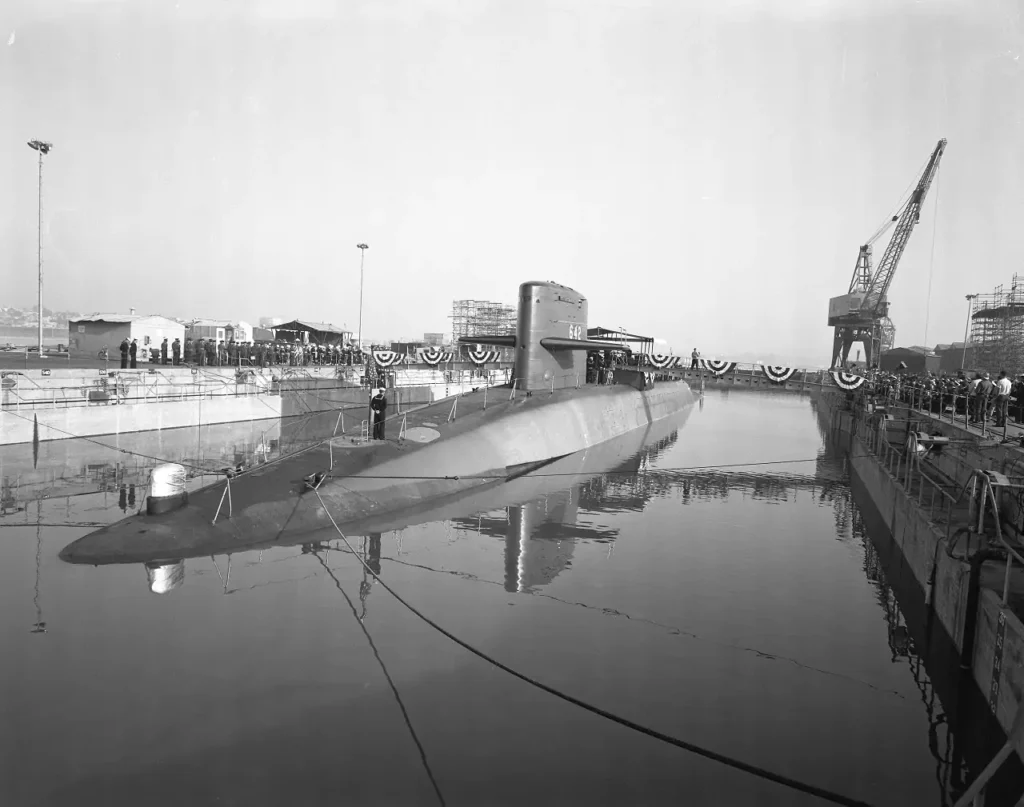
The average price for a 640-class submarine stood at roughly $66 million per boat. The addition of the nuclear reactor, electronics, weapon systems, and specialized equipment raised the total to $116 million. This figure excludes the price of 16 missiles, which cost an average of $1.7 million each, excluding the warheads.
| No. | Name | Builder | Keel Laid | Launched | Comm. |
|---|---|---|---|---|---|
| SSBN 640 | Benjamin Franklin | Electric Boat | 25 May 1963 | 5 Dec 1964 | 22 Oct 1965 |
| SSBN 641 | Simon Bolivar | Newport News | 17 Apr 1963 | 22 Aug 1964 | 29 Oct 1965 |
| SSBN 642 | Kamehameha | Mare I NSYd | 2 May 1963 | 16 Jan 1965 | 10 Dec 1965 |
| SSBN 643 | George Bancroft | Electric Boat | 24 Aug 1963 | 20 Mar 1965 | 22 Jan 1966 |
| SSBN 644 | Lewis and Clark | Newport News | 29 Jul 1963 | 21 Nov 1964 | 22 Dec 1965 |
| SSBN 645 | James K. Polk | Electric Boat | 23 Nov 1963 | 22 May 1965 | 16 Apr 1966 |
| SSBN 654 | George C. Marshall | Newport News | 2 Mar 1964 | 21 May 1965 | 29 Apr 1966 |
| SSBN 655 | Henry L. Stimson | Electric Boat | 4 Apr 1964 | 13 Nov 1965 | 20 Aug 1966 |
| SSBN 656 | George Washington Carver | Newport News | 24 Aug 1964 | 14 Aug 1965 | 15 Jun 1966 |
| SSBN 657 | Francis Scott Key | Electric Boat | 5 Dec 1964 | 23 Apr 1966 | 3 Dec 1966 |
| SSBN 658 | Mariano G. Vallejo | Mare I NSYd | 7 Jul 1964 | 23 Oct 1965 | 16 Dec 1966 |
| SSBN 659 | Will Rogers | Electric Boat | 20 Mar 1965 | 21 Jul 1966 | 1 Apr 1967 |
Service
The Simon Bolivar, the first Benjamin Franklin class submarine, was launched on August 22, 1964, a year later than expected, and was commissioned on October 29, 1965, a week following the Benjamin Franklin. It embarked on its first deterrent patrol in the Atlantic on April 27, 1966, while Benjamin Franklin joined the Pacific fleet on May 7.
The class deployment was concluded on October 3, 1967, as the USS Will Rogers embarked on its first war patrol.
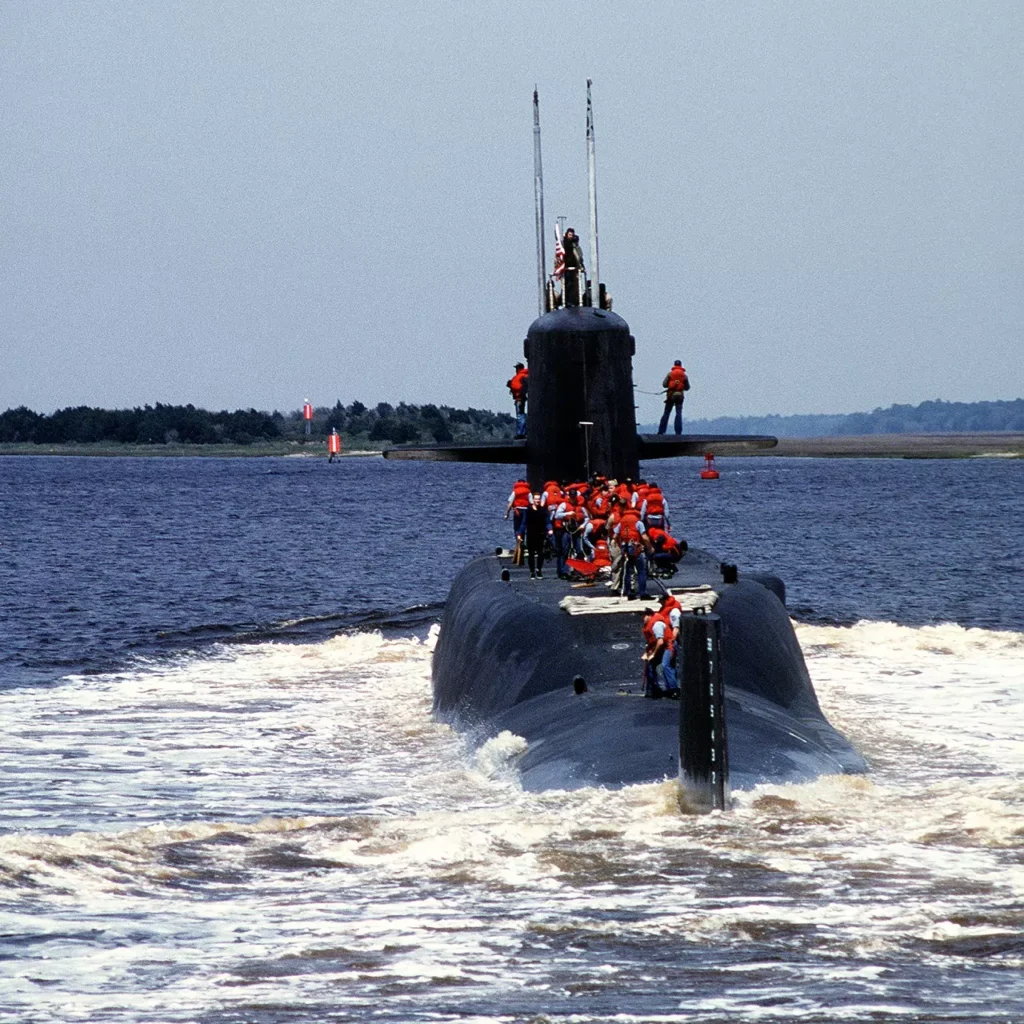
Initially, the submarines in this class were deployed with the Polaris A-3 missile. However, beginning in November 1972, they started being equipped with Poseidon C-4, with the rearming process concluding by September 1974.
In the following table, the details of the conversion to Poseidon are shown:
| No. | FY Program | Conversion Yard | Start | Complete |
|---|---|---|---|---|
| SSBN 640 | 1971 | Electric Boat | 25 Feb 1971 | 15 May 1972 |
| SSBN 641 | 1971 | Newport News | 15 Feb 1971 | 12 May 1972 |
| SSBN 642 | 1972 | Electric Boat | 15 July 1971 | 27 Oct 1972 |
| SSBN 643 | 1971 | Portsmouth NSYd | 28 Apr 1971 | 31 July 1972 |
| SSBN 644 | 1971 | Puget Sound NSYd | 30 Apr 1971 | 21 July 1972 |
| SSBN 645 | 1972 | Newport News | 15 July 1971 | 17 Nov 1972 |
| SSBN 654 | 1972 | Puget Sound NSYd | 14 Sep 1971 | 8 Feb 1973 |
| SSBN 655 | 1972 | Newport News | 15 Nov 1971 | 22 Mar 1973 |
| SSBN 656 | 1972 | Electric Boat | 12 Nov 1971 | 7 Apr 1973 |
| SSBN 657 | 1972 | Puget Sound NSYd | 20 Feb 1972 | 17 May 1973 |
| SSBN 658 | 1973 | Newport News | 21 Aug 1972 | 19 Dec 1973 |
| SSBN 659 | 1973 | Portsmouth NSYd | 16 Oct 1972 | 8 Feb 1974 |
On October 20, 1979, the submarine USS Francis Scott Key became operational with the Trident I missile.
The Trident I deployment was finalized on July 20, 1982, following the rearming of Francis Scott Key, Henry L. Stimson, Mariano G. Vallejo, Benjamin Franklin, Simon Bolivar, and George Bancroft.
Decommission
The Benjamin Franklin class was decommissioned in response to the START I nuclear reduction initiatives, and all missile systems were removed. These initiatives required a significant reduction in strategic weapon systems, including existing and future intercontinental missile systems.
By 1992, the Lewis and Clark, George Marshall, George W. Carver, and Will Rogers had been decommissioned.
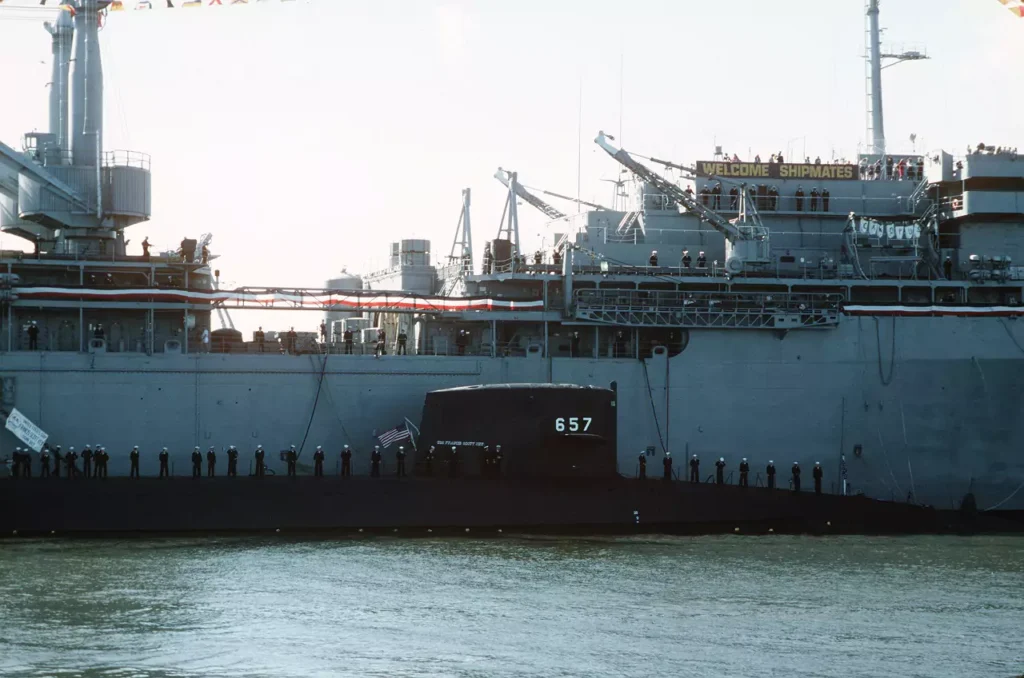
By the end of 1993, Benjamin Franklin, Simon Bolivar, George Bancroft, and Henry L. Stimson were put on stand-down status, leaving only Kamehameha, James K. Polk, and Mariano G. Vallejo in service.
This resulted in only five operational Lafayette-style ballistic missile submarines by 1994.
| No. | Name | Decomm. | Striken | Broken up |
|---|---|---|---|---|
| SSBN 640 | Benjamin Franklin | 23 Nov 1993 | 23 Nov 1993 | 1995 |
| SSBN 641 | Simon Bolivar | 8 Feb 1995 | 8 Feb 1995 | 1995 |
| SSBN 642 | Kamehameha | 4 Aug 2001 | 2 Apr 2002 | 2003 |
| SSBN 643 | George Bancroft | 21 Sep 1993 | 21 Sep 1993 | 1998 |
| SSBN 644 | Lewis and Clark | 1 Aug 1992 | 1 Aug 1992 | 1996 |
| SSBN 645 | James K. Polk | 8 Jul 1999 | 8 Jul 1999 | 2000 |
| SSBN 654 | George C. Marshall | 24 Sep 1992 | 24 Sep 1992 | 1994 |
| SSBN 655 | Henry L. Stimson | 5 May 1993 | 5 May 1993 | 1994 |
| SSBN 656 | George Washington Carver | 18 Mar 1993 | 18 Mar 1993 | 1994 |
| SSBN 657 | Francis Scott Key | 2 Sep 1993 | 2 Sep 1993 | 1995 |
| SSBN 658 | Mariano G. Vallejo | 10 Mar 1995 | 10 Mar 1995 | 1995 |
| SSBN 659 | Will Rogers | 12 Apr 1993 | 12 Apr 1993 | 1994 |
Two of these submarines, the Kamehameha and the James K. Polk, were converted into attack submarines suitable for SEAL missions in March 1994.
When the Polk was inactivated in January 1999, the Kamehameha remained the only former ballistic missile submarine with dry deck shelters. However, by 2002, the Kamehameha was also decommissioned.
Further reading
Bibliography
- Polmar, N., Moore, K. J. (2014). Cold War Submarines: The Design and Construction of U.S. and Soviet Submarines. United States: Potomac Books, Incorporated.
- Polmar, N. (1993). The Naval Institute Guide to the Ships and Aircraft of the U.S. Fleet, 15th Edition. United States: Naval Institute Press.
- Gibson, J. N. (1996). Nuclear Weapons of the United States: An Illustrated History. United States: Schiffer Publishing.
- Adcock, A. (1993). U.S. Ballistic Missile Subs in Action. United States: Squadron/Signal Publications.
- Friedman, N. (1995). U.S. submarines through 1945: an illustrated design history. United States: Naval Institute Press.
These boats had two hull mounted sonar arrays. One conformal and one cylindrical. The BQR-7 used the conformal array. The BQR-21 used the cylindrical array.